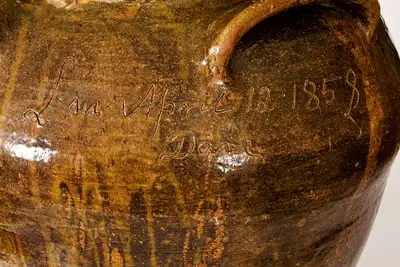Who was David Drake?
In the 1820s, Drake began developing his skills while working for the Landrum family; the Landrums operated pottery kilns using the labour of enslaved Black Americans, Free Black Americans, and European-Americans in the Edgefield district (Goldberg and Goldberg, 2017). Drake also worked at the Stony Bluff Manufactory in the same region for enslaver Lewis Miles before his legal emancipation in 1938. His work was very labour-intensive; some pots had a capacity of greater than twenty gallons (Goldberg and Goldberg 2017).
During this time, Drake cleverly resisted oppression by inscribing the very pots he was forced to create with words, biblical references, and poetics. Literacy was illegal for enslaved Black people and so, Drake's inscriptions are provocative, providing crucial insight into his internal world both as an artisan as a Black person during the antebellum period.

“I wonder where is all my relations/Friendship to all – and every nation.”
Inscription taken from one of David Drake’s vessels. (Source)
The commodification of David Drake’s work
As an enslaved Black man, Drake’s labour and expertise were exploited for profit under vile conditions by each of the five enslavers he worked under before his emancipation (Goldberg and Goldberg, 2017). To this day, profits are still procured from Drake’s labour and the knowledge he produced with inscriptions. Museums buy and sell his pots, as well as private stoneware auctioneers like Crocker Farm.
This plight still impacts Black creators today. Profits are made from Black knowledge and material production and are not necessarily re-invested in our communities to aid in our liberation.
However, Drake still found a way to be disruptive and to resist. We must do the same in our contemporary context and honour his legacy.
Screenshot taken from The Crocker Farms Website on Sept 17, 2022. Note that one of David Drake’s vessels was sold for over 1 million dollars.
In an earlier work, Drake incised two words on two separate pots which express his thoughts as an abolitionist and resistance towards slavery. “Concatination” (Concatenation) was inscribed by Drake on June 12th, 1834. Drake inscribed “Catination ” (Catenation) onto another pot on April 12th, 1836. (Goldberg and Goldberg, 2017) These words, referencing linkage and chains, give us insight into Drake’s deep inner world, that questioned the material conditions of his time.
Image Details: David Drake, 1858. Inscription: "A very Large Jar which has 4 handles / pack it full of fresh meats- then light candles".
Edgefield potters and revolutionising alkaline glaze
While researching Black ceramic traditions, we came across the Edgefield Potters who created “face jugs” in stoneware. Southern stoneware is a creolization of Black Diasporic, European and Chinese ceramic form (Fennell, 2017). Artisans turned impressive pots on foot-powered treadle wheels that were derived from European ceramic traditions (Fennell, 2017).
Specifically, Edgefield Artisans were able to develop an alkaline glaze through natural resources such as wood, ash, silica in the form of sand, crushed glass or iron cinders (Fennell, 2017). The result was an alkaline glaze that ranged from a yellow-green to green olive color, a distinctive feature of Drake’s pots.
How does this apply today?
As researchers, we noticed parallels between Drake’s condition in the early nineteenth century and our own today. Often as Black creatives, our cultural work is appropriated. A recent example is the strike by Black Tiktok content creators. We find ways to resist the patterns in society that attempt to undermine our work; Drake wrote his name on the pots he was forced to make, and we demand credit for our role in what is considered pop culture.
Additionally, contemporary Black artists across the globe have looked towards Drake’s poetics as a point of reference. To learn more about each artist and the unique ways they are honoring Drake’s legacy, click the names below.
References
Fennell, Christopher C. “Innovation, Industry, and African-American Heritage in Edgefield, South Carolina.” Journal of African Diaspora Archaeology and Heritage 6, no. 2 (2017): 55–77. https://doi.org/10.1080/21619441.2017.1345105.
Goldberg, Arthur F., and Deborah A. Goldberg. “The Expanding Legacy of the Enslaved Potter-Poet David Drake.” Journal of African Diaspora Archaeology and Heritage 6, no. 3 (2017): 243–61. https://doi.org/10.1080/21619441.2017.1385953.




